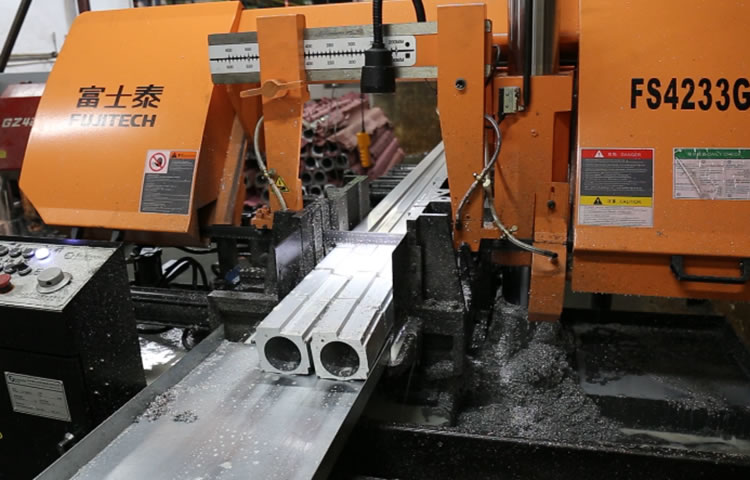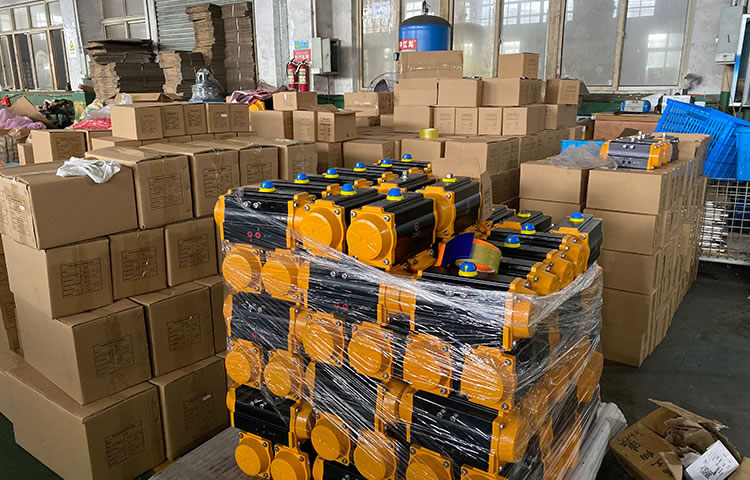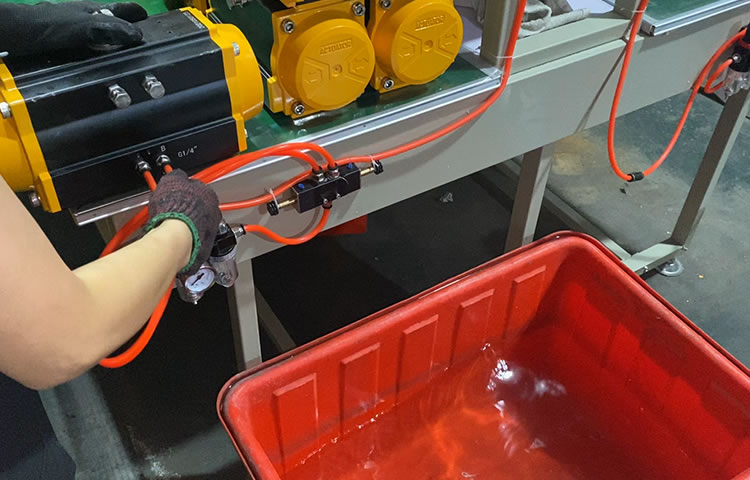Pneumatic Actuator
Manufacturing pneumatic actuators in single-acting and double-acting types. Elevate Your Efficiency with Advanced Pneumatic Solutions.
Manufacturing pneumatic actuators in single-acting and double-acting types. Elevate Your Efficiency with Advanced Pneumatic Solutions.
A pneumatic actuator is a device used to control fluid media. The pneumatic actuator is usually installed on valves, regulating valves, and other control devices.
The Pneumatic Actuator designed for Ball Valves and Butterfly Valves represents the zenith of our ceaseless dedication to attaining technical excellence, unrivaled quality, and preeminent industry acumen. This revolutionary apparatus is specifically crafted to transmute compressed air into mechanical movement, facilitating effortless and precise regulation of valve positioning within various industrial processes.
The Valve Pneumatic Actuator, tailored for Ball Valves and Butterfly Valves, affirms extraordinary functionality and sturdily built architecture. It houses a high-performing pneumatic motor, meticulously engineered to convert compressed air into mechanical torque with the least amount of energy dissipation. This motor interfaces flawlessly with a resilient gearing mechanism to amplify torque production and guarantee seamless, dependable operation.
A Valve Pneumatic Actuator is a particular kind of actuator that harnesses pressurized air to create force and shift objects from one location to another. It finds application in both industrial and commercial settings, for instance, in the functioning of valves, clutches, ball valves, butterfly valves, and other mechanical equipment. In general, these actuators possess the ability to offer high speed while maintaining low power consumption, which is a crucial aspect when contemplating the utilization of pneumatics for extensive applications.
Pneumatic Actuators are typically driven by an air compressor that is linked to a piping network leading to the actuating mechanism. Subsequently, a control unit dictates whether the actuator should open or close by user specifications. A variety of controls can be implemented to adjust the desired speed and precision: manual push-button controls (for basic systems), solenoid valve control (for more sizable systems), or computerized programmable logic controllers (to achieve comprehensive closed-loop control).
Explore two varieties of pneumatic actuators: the space-efficient compact rack and pinion model, which exhibits a remarkable output torque of 8000NM, and the powerful scotch yoke model, capable of generating an outstanding output torque of 100000NM.
Presenting the highly adaptable pneumatic actuator, which is ideally suited for butterfly valves, ball valves, and plug valves. This quarter-turn titan features ISO5211 connection dimensions, ensuring effortless and smooth integration.
Pneumatic actuators possess remarkable versatility and are applicable across a broad spectrum of uses. To augment their efficacy, a variety of pneumatic accessories exist, which can improve both their performance and functionality. These encompass:
Positioners: Positioners enable precise control over the actuator’s position by offering feedback to the system controller. This facilitates enhanced accuracy in the control of pressure or force.
Solenoid Valves: Solenoid valves operate by opening and closing in response to an electrical signal, thereby enabling you to remotely manage your pneumatic actuator more conveniently than ever.
Silencers / Mufflers: Exhaust silencers are designed to diminish the noise emitted from the exhaust port of the pneumatic actuator, thus guaranteeing a quieter operational mode and an improved working environment.
Filters/Regulators/Lubricators (FRL): FRLs are essential for maintaining the optimal performance of pneumatic components. They provide proper lubrication and regulate air pressure both upstream and downstream of the valve or cylinder assembly. This not only maximizes operational efficiency, leading to cost savings in the long run, but also extends the lifespan of various components such as hoses, seals, and fittings.
Pressure Switches/Monitors: Pressure switches can bring about automatic shutoff once specific pressures are attained. Meanwhile, monitors offer precise readings regarding pressure levels at any instant through an electronic display panel or digital readout.
Cylinder Sensors & Switches (Valve Monitors): Valve monitors incorporate sensors that are strategically positioned along the pipework. These sensors keep track of flow rates, velocity differences, temperatures, and more. This allows you to manage the operational speed effectively and significantly reduce delays that might result from inaccurate data readings, such as those related to the air consumption rate, from these crucial sources.
Limit Switches & Lawfully Operated (LPs): Limit switches function as safeguards, halting operating systems when they reach the preset boundaries determined by engineers. This ensures precision within the designated safe zones. Without such fail-safe mechanisms like limit switches, the system could potentially operate in an uncontrolled manner if unrestricted user access were permitted. LPs enhance safety protocols even further by diminishing the risk factors that emerge during malfunctions associated with regular use in automation processes.
Pneumatic and electric actuators represent two distinct technologies for converting energy into motion. Pneumatic actuators rely on compressed air, whereas electric actuators utilize an electronic signal. This constitutes one of the most basic differences between the two technologies. Nevertheless, there are additional crucial distinctions that merit attention.
The principal benefit of pneumatic actuators lies in their low cost and uncomplicated maintenance needs. Pneumatics also provide a high power-to-weight ratio, indicating that they can be employed in applications where strength is a necessity yet space is restricted. Moreover, pneumatics have comparatively rapid response times, which renders them valuable in applications involving dynamic systems such as conveyor belts or robotic arms that demand frequent modifications.
Unlike pneumatic actuators, electric actuators boast higher accuracy and repeatability thanks to their continuous torque output. This makes them perfect for automated manufacturing processes that demand precise control over movement. Furthermore, electric motors are available in a diverse range of sizes and designs, thus offering more flexible choices when it comes to integrating with existing systems or structures that have components unable to accommodate traditional air cylinders or motors. Electric motors also generate less noise compared to their pneumatic counterparts, which makes them fit for environments where lower noise levels are essential, such as hospital operating rooms or recording studios.
To adjust the 0° position, loosen the fastening nut and twist the positioning screw back and forth to adjust the positive and negative angles. The 90° position adjustment is the same as the 0° position. The positive and negative adjustment angles of the 90° and 0° positions cannot exceed 5°. It can be modified if there are special needs.
Reverse installation of pneumatic actuator
Loosen the fastening nut, withdraw the positioning screw, remove the fixing screw and side cover, pull out the piston, reverse the piston and rotate the gear shaft to the appropriate position, install the piston, lock the side cover, and twist the positioning screw to the proper position. , locking nut, the rotation direction of the rear pinion of the reverse installation of the piston is opposite to that of the formal installation.
Before selecting a pneumatic actuator, please confirm the valve torque. And increase the safety value on the torque, water vapor or non-lubricating liquid medium increases the safety value by 25%; non-lubricating slurry liquid medium increases the safety value by 30%.
The selected valve torque is 210NM, the air source pressure is only 5 bar, and the medium is non-lubricated water vapor. Considering safety factors, increase the safety value by 25%, which is 262NM. According to the double-acting output torque table, find the corresponding torque when the air source pressure is 5 bar. Value. 277NM should be selected, model DA300.





Based on a wealth of experience, YUECHI has the knowledge to provide reliable and appropriate automotive solutions for valve applications. General technical attributes for product selection include:

valve type, operating pressure, valve size, sealing type(hard sealed and soft sealed options) ,media and operating temperature

Double-acting and spring-return configurations (normally closed and normally open options)

Double-solenoid or single-solenoid, supply voltage, explosion-proof type

Basic or explosion-proof type

Current signal, air supply signal, electric-pneumatic converters, explosion-proof grade

Air filter, Solenoid Valve, Limit Switches Box

De-clutch able wormgear

Accessories of designated brand